
One of the most frequently asked questions we get asked at our office is “What age do kids usually get braces?”. This is a great question and there is not a specific answer as each child’s case will vary and depend upon their growth and development. At Bovenizer and Baker Orthodontics, we take deciding when to start treatment very seriously and it is part of our mission statement, core values, and we consider this a differentiator in our practice.
When should a child be seen by an orthodontist”?
Without hesitation, a child should be seen by the age of 7 and this is the age that is recommended by the American Association of Orthodontics. Age 7 is when a child should have all four 6 year molars and the upper and lower incisors should be erupting as well. You would think this would be an easy process, but it is not always the case. Sometimes, the 6 year molars get caught under the last primary molar and other eruption issues can be diagnosed. If an orthodontist catches this early, oftentimes early treatment can be utilized. In fact in our office, early treatment (often called “Phase I”) only occurs in about 5% of the children evaluated.
What age do kids usually get braces?
The overall average age is 12-13 years old, but we examine many children starting at age 7 and monitor them in our Observation Program. We look at several key aspects when deciding to place an adolescent in braces or Invisalign treatment. We like for most, if not all the teeth, to be developed and in the oral cavity, including the 12 year molars. Sometimes, when crowding exists not all teeth can erupt or come in, but the lower 12 year molars are key. We also watch when a child is going through an adolescent growth spurt because this is when we can intervene on growth if we need to. Another thing we take into consideration is whether the child has the physical and mental maturity to be able to “handle” braces, take care of them, clean their teeth properly and wear the right elastics.
What is the Kid’s Club / Observation Program?
Our Kid’s Club program allows for your child to be seen in our office for annual, complimentary checks of their teeth to monitor growth and development and ensure that early intervention is not necessary. We complete 3D diagnostic x-rays and do not charge for this service. We make the Observation Program very interactive for the entire family. The kids can spin our prize wheel and win prizes at each appointment! They will also receive a Patient Rewards Hub card to get points for good grades in school, good hygiene and many other things. Patients can then redeem the points they earn for prizes and gift cards. We really do try our absolute best to treat people how we want our own children and families to be treated and our goal is to make our patients excited to come into the office!
What is Phase 1 treatment?
For quite some time orthodontics is often discussed as Phase I and Phase 2. This simply means that for some patients there is often early intervention or Phase I treatment that is started when a child is young, usually 7-9 years of age, with a mix of primary and permanent teeth. Then there is a period of time until that child loses the rest of their primary teeth and Phase 2 of treatment is begun when all the permanent teeth are in the mouth.
Why is observation so important and why is it such a big part of the Bovenizer and Baker practice philosophy?
We have made conservative treatment start times one of the main focuses of our practice. We treat everyone like they are family…this is easy to say, however is it easy to do? When the practice opened in 2006, it started with a simple practice mission…to become one of the premier orthodontic practices built upon results, trust and community. Dr. Bovenizer was also never really a big proponent of Phase I treatment. It has never really made sense to him to do things twice if they can be done in one comprehensive treatment. Now, this does not mean that Phase I is a bad choice. Dr. Bo and Dr. Baker want individuals to know that most of the time they feel that one comprehensive treatment can be completed in an adolescent and be very successful.

